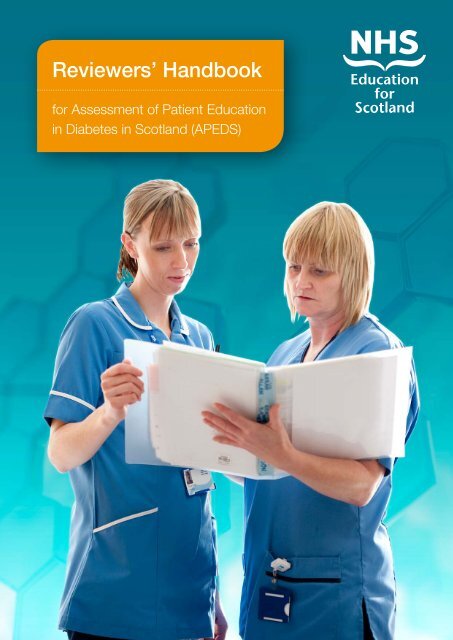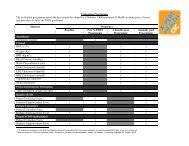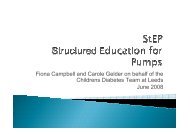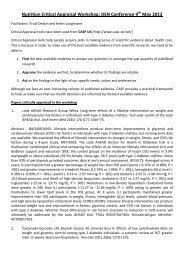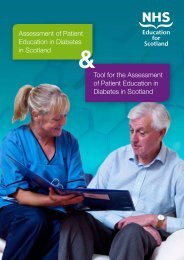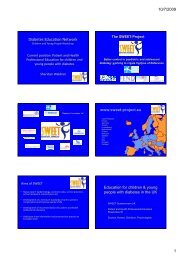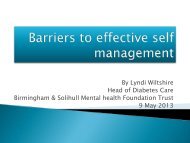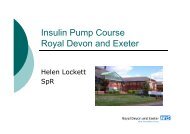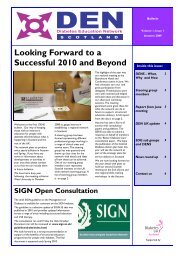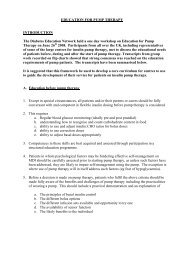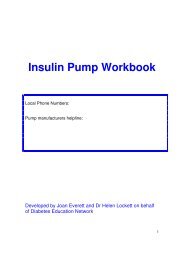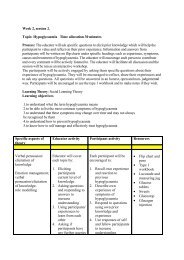Reviewers' Handbook for Assessment of Patient Education in ...
Reviewers' Handbook for Assessment of Patient Education in ...
Reviewers' Handbook for Assessment of Patient Education in ...
You also want an ePaper? Increase the reach of your titles
YUMPU automatically turns print PDFs into web optimized ePapers that Google loves.
Reviewers’ <strong>Handbook</strong><br />
<strong>for</strong> <strong>Assessment</strong> <strong>of</strong> <strong>Patient</strong> <strong>Education</strong><br />
<strong>in</strong> Diabetes <strong>in</strong> Scotland (APEDS)
Contents<br />
Reviewers’ <strong>Handbook</strong> <strong>for</strong> <strong>Assessment</strong> <strong>of</strong> <strong>Patient</strong> <strong>Education</strong> <strong>in</strong><br />
Diabetes <strong>in</strong> Scotland (APEDS)<br />
Introduction....................................................................................................................................... 1<br />
Review Process ................................................................................................................................ 2<br />
Term<strong>in</strong>ology....................................................................................................................................... 3<br />
General Aspects................................................................................................................................ 3<br />
Philosophy......................................................................................................................................... 4<br />
Curriculum, Aims and Learn<strong>in</strong>g Outcomes...................................................................................... 4<br />
Tra<strong>in</strong>ed Educator............................................................................................................................... 5<br />
Quality Assurance............................................................................................................................. 6<br />
Audit.................................................................................................................................................. 2<br />
patient aspects.............................................................................................................................. 6<br />
pr<strong>of</strong>essional aspects...................................................................................................................... 7<br />
organisational aspects................................................................................................................... 7<br />
References........................................................................................................................................ 8<br />
Appendix<br />
1. SCI-Diabetes Descriptors <strong>of</strong> structured education.......................................................................... 9<br />
2. Review <strong>of</strong> Structured <strong>Patient</strong> <strong>Education</strong>....................................................................................... 14<br />
3. Report<strong>in</strong>g template <strong>for</strong> acceptable Programme............................................................................ 19<br />
4. Report<strong>in</strong>g template <strong>for</strong> m<strong>in</strong>or adjustments to the Programme...................................................... 20<br />
5. Action plan template.................................................................................................................... 21<br />
Acknowledgements: This document was developed by a variety <strong>of</strong> people through consultations and<br />
workshops. Contributors were people with diabetes and pr<strong>of</strong>essionals from all Health Boards, <strong>Education</strong>al<br />
Leads <strong>in</strong> Diabetes, the Steer<strong>in</strong>g Group <strong>for</strong> the National <strong>Education</strong> Co-Ord<strong>in</strong>ator and members <strong>of</strong> the<br />
Scottish Diabetes <strong>Education</strong> Advisory Group.<br />
© NHS <strong>Education</strong> <strong>for</strong> Scotland 2012. You can copy or reproduce the <strong>in</strong><strong>for</strong>mation <strong>in</strong> this<br />
document <strong>for</strong> use with<strong>in</strong> NHSScotland and <strong>for</strong> non‐commercial educational purposes.<br />
Use <strong>of</strong> this document <strong>for</strong> commercial purposes is permitted only with the written<br />
permission <strong>of</strong> NES.
Reviewer’s <strong>Handbook</strong><br />
This handbook must be read and utilized <strong>in</strong><br />
conjunction with the <strong>Assessment</strong> <strong>of</strong> <strong>Patient</strong><br />
<strong>Education</strong> <strong>in</strong> Diabetes <strong>in</strong> Scotland (APEDS)<br />
and Tool <strong>for</strong> <strong>Assessment</strong> <strong>of</strong> <strong>Patient</strong> <strong>Education</strong><br />
<strong>in</strong> Diabetes <strong>in</strong> Scotland (TAPEDS) and the<br />
descriptors <strong>for</strong> record<strong>in</strong>g structured patient<br />
education on SCI-Diabetes (Appendix 1).<br />
The ethos <strong>for</strong> review<strong>in</strong>g educational<br />
programmes is <strong>of</strong> support and valu<strong>in</strong>g quality.<br />
It should be a constructive experience <strong>for</strong> both<br />
reviewers and reviewees.<br />
Introduction<br />
The ma<strong>in</strong> outcome <strong>of</strong> review<strong>in</strong>g structured patient<br />
education is to record education received by each<br />
person with diabetes on SCI-Diabetes and so lay<br />
the foundation <strong>for</strong> quality assured, <strong>in</strong>cremental<br />
education be<strong>in</strong>g received by each <strong>in</strong>dividual liv<strong>in</strong>g<br />
with diabetes. A secondary outcome is to <strong>in</strong>crease<br />
the quantity and quality <strong>of</strong> education <strong>of</strong>fered to<br />
people liv<strong>in</strong>g with diabetes throughout Scotland.<br />
Reviewers have been nom<strong>in</strong>ated by the<br />
<strong>Education</strong>al Leads <strong>in</strong> each Health Board<br />
represent<strong>in</strong>g people with diabetes and<br />
pr<strong>of</strong>essionals from all discipl<strong>in</strong>es <strong>in</strong>volved <strong>in</strong><br />
diabetes care. Reviewers are considered by their<br />
peers to meet the follow<strong>in</strong>g criteria:<br />
• actively <strong>in</strong>volved <strong>in</strong> deliver<strong>in</strong>g patient<br />
education to people with diabetes or a<br />
person liv<strong>in</strong>g with diabetes who is actively<br />
<strong>in</strong>volved <strong>in</strong> self-management and relates<br />
well to others<br />
• are tra<strong>in</strong>ed educators or a person liv<strong>in</strong>g with<br />
diabetes who demonstrates the ability to<br />
educate others – not necessarily <strong>in</strong> diabetes<br />
• have capacity <strong>for</strong> undertak<strong>in</strong>g reviews<br />
• have a collegiate approach<br />
• have a strategic approach to care<br />
• command the respect and <strong>in</strong>tegrity <strong>of</strong> their<br />
colleagues<br />
• are will<strong>in</strong>g to commit as a reviewer <strong>for</strong> a<br />
m<strong>in</strong>imum <strong>of</strong> 3 years<br />
• are will<strong>in</strong>g to undergo tra<strong>in</strong><strong>in</strong>g to be a<br />
reviewer<br />
It is expected that the workload would be the<br />
equivalent <strong>of</strong> 2 days <strong>for</strong> each programme be<strong>in</strong>g<br />
reviewed. Reviews will be conducted electronically<br />
with some telephone or email communications.<br />
INTRODUCTION<br />
1
Review Process <strong>for</strong> assess<strong>in</strong>g structured patient<br />
education programmes<br />
1. Health Boards will be <strong>in</strong>vited to submit their<br />
Programme Documentation <strong>for</strong> assessment<br />
to the Scottish Diabetes <strong>Education</strong> Advisory<br />
Group. The TAPEDS will <strong>in</strong><strong>for</strong>m the material<br />
to be submitted. Electronic submissions are<br />
required.<br />
2. Submitted Programme Documentation will<br />
be sent to reviewers who will live or work <strong>in</strong> a<br />
different Health Board than the Programme <strong>for</strong><br />
review.<br />
3. There will normally be three reviewers <strong>for</strong> each<br />
submitted programme and must <strong>in</strong>clude one<br />
person with diabetes and one pr<strong>of</strong>essional. The<br />
third person may be another person liv<strong>in</strong>g with<br />
diabetes or another pr<strong>of</strong>essional, preferably<br />
from a different pr<strong>of</strong>essional group than the first<br />
one. One person will be identified as the Lead<br />
Reviewer.<br />
4. The Lead Reviewer is responsible <strong>for</strong> cocoord<strong>in</strong>at<strong>in</strong>g<br />
the responses <strong>of</strong> the other<br />
reviewers and communicat<strong>in</strong>g the outcome<br />
to the Scottish Diabetes <strong>Education</strong> Advisory<br />
Group. All reviewers are expected to fulfill this<br />
role on a rotational basis.<br />
5. The reviewers will <strong>in</strong>dividually review the<br />
programme accord<strong>in</strong>g to the TAPEDS template<br />
(Appendix 2).<br />
6. The reviewers will communicate with each<br />
other with regard to their f<strong>in</strong>d<strong>in</strong>gs, identify<strong>in</strong>g<br />
any areas that need further exploration or<br />
clarification.<br />
8. After any further exploratory communications,<br />
the reviewers will agree on the outcome.<br />
9. The above process should be completed with<strong>in</strong><br />
6 weeks <strong>of</strong> any Programme be<strong>in</strong>g submitted<br />
<strong>for</strong> assessment.<br />
10. The outcome may be:<br />
a) The programme is acceptable <strong>for</strong> record<strong>in</strong>g<br />
on SCI-Diabetes (Appendix 3)<br />
b) The programme is acceptable <strong>for</strong> record<strong>in</strong>g<br />
on SCI-Diabetes subject to m<strong>in</strong>or<br />
adjustments that must be undertaken<br />
with<strong>in</strong> 3 months (Appendix 4). At the end <strong>of</strong><br />
3 months, the <strong>Education</strong>al Lead will submit<br />
amendments to the orig<strong>in</strong>al reviewers who<br />
will determ<strong>in</strong>e if the adjustments have been<br />
made.<br />
c) The programme is not yet acceptable <strong>for</strong><br />
record<strong>in</strong>g on SCI-Diabetes. A detailed<br />
action plan will be compiled (Appendix<br />
5) and the submitt<strong>in</strong>g <strong>Education</strong>al Lead<br />
asked to address it. The <strong>Education</strong>al Lead<br />
will be given 6 months to re-submit the<br />
Programme, with amendments, to the<br />
orig<strong>in</strong>al reviewers who will determ<strong>in</strong>e if the<br />
adjustments have been made.<br />
d) Records <strong>of</strong> Programmes acceptable <strong>for</strong><br />
record<strong>in</strong>g on SCI-Diabetes will be reta<strong>in</strong>ed<br />
by the Scottish Diabetes Group.<br />
7. The Lead Reviewer will communicate with<br />
the <strong>Education</strong>al Lead <strong>for</strong> the Programme <strong>for</strong><br />
clarification <strong>of</strong> any identified area. This may be<br />
by telephone, Skype, or <strong>in</strong>dependent visit. All<br />
reviewers will be encouraged to participate <strong>in</strong><br />
these communications but the Lead Reviewer<br />
is the only one required to participate.<br />
2 REVIEWERS’ HANDBOOK FOR ASSESSMENT OF PATIENT EDUCATION IN DIABETES IN SCOTLAND (APEDS)
Term<strong>in</strong>ology<br />
It is important that the same language is used when referr<strong>in</strong>g to submitted Programmes. For this purpose, a<br />
list <strong>of</strong> the most common term<strong>in</strong>ology used is presented. This is <strong>in</strong> sequential order.<br />
Programme<br />
This relates to an entire educational experience.<br />
Normally education will be delivered over several<br />
hours, days or weeks. Programme relates to all the<br />
sessions delivered.<br />
Some Programmes may be delivered over one<br />
session e.g. Diabetes Footsteps developed under<br />
the auspices <strong>of</strong> Fife Health Board. A one session<br />
programme is still required to meet all the criteria <strong>of</strong><br />
a programme.<br />
National Course<br />
This relates to those courses that have been<br />
developed under the auspices <strong>of</strong> research,<br />
normally a randomized control trial. Examples are:<br />
DAFNE, DESMOND, X-PERT Diabetes.<br />
Session<br />
This relates to one <strong>in</strong>dividual educational<br />
experience. It may occur <strong>in</strong> a group sett<strong>in</strong>g or on a<br />
one-to-one sett<strong>in</strong>g. It may be conducted face-t<strong>of</strong>ace,<br />
over the telephone or other media.<br />
Ongo<strong>in</strong>g education<br />
This relates to level 2 education 1 . As such, it<br />
normally relates to one <strong>in</strong>dividual educational<br />
session. However, any level 2 education submitted<br />
<strong>for</strong> review must meet the criteria <strong>of</strong> a programme.<br />
Indicative content<br />
This is a list <strong>of</strong> topics that will be addressed.<br />
The <strong>in</strong>dicative content may refer to the whole<br />
programme or may refer to one teach<strong>in</strong>g session.<br />
A national course is not required to be reviewed<br />
us<strong>in</strong>g the APEDS and TAPEDS so long as it is<br />
be<strong>in</strong>g reviewed by its authoriz<strong>in</strong>g body and it has<br />
not been modified <strong>in</strong> any way.<br />
General Aspects<br />
Reviewers are asked to read the follow<strong>in</strong>g pages<br />
<strong>in</strong> tandem with Appendix 2 and the submitted<br />
Programme <strong>for</strong> review. Each reviewer should<br />
complete Appendix 2 <strong>in</strong>dependently from other<br />
reviewers and us<strong>in</strong>g the Programme <strong>in</strong><strong>for</strong>mation<br />
submitted. The boxes will expand to accept written<br />
text. There are a few key components to note.<br />
If this is a national course that has been modified, it<br />
is important that such modifications are noted, <strong>for</strong><br />
example, the duration <strong>of</strong> the programme, its tim<strong>in</strong>g,<br />
the content or any different resources utilized.<br />
There are a variety <strong>of</strong> ways <strong>in</strong> which people’s<br />
learn<strong>in</strong>g needs are identified. If a person has<br />
been just diagnosed with diabetes, there is<br />
clearly a self-management need. If however a<br />
person has ongo<strong>in</strong>g problems with, <strong>for</strong> example,<br />
hypoglycaemia, their learn<strong>in</strong>g need may be<br />
identified by a cl<strong>in</strong>ical requirement. Very few<br />
Programmes <strong>for</strong>mally assess people’s learn<strong>in</strong>g<br />
needs and hence this may not be explicit <strong>in</strong><br />
Programme documentation.<br />
TERMINOLOGY<br />
3
Philosophy<br />
The philosophy <strong>of</strong> the Programme may be<br />
presented as a mission statement, a philosophy<br />
or as an overall ethos. The philosophy should<br />
be communicated to participants, pr<strong>of</strong>essionals<br />
referr<strong>in</strong>g participants to the Programme and to<br />
those participat<strong>in</strong>g <strong>in</strong> deliver<strong>in</strong>g the Programme.<br />
Hence, there should be evidence <strong>of</strong> the philosophy<br />
on all communications with others.<br />
It is good practice to <strong>in</strong>volve people with diabetes<br />
<strong>in</strong> the development <strong>of</strong> the philosophy however, if<br />
the Programme is well established, this level <strong>of</strong><br />
detail may not be obvious.<br />
Curriculum, Aims and Learn<strong>in</strong>g Outcomes<br />
The educational theory should support active<br />
learn<strong>in</strong>g by the participants. It may employ adult<br />
learn<strong>in</strong>g theory or child specific learn<strong>in</strong>g theories.<br />
Any educational programme will have a<br />
Programme Aim that is normally one sentence<br />
<strong>in</strong>dicat<strong>in</strong>g the overall purpose <strong>of</strong> the Programme.<br />
Thereafter, the Programme normally has about 4-6<br />
learn<strong>in</strong>g outcomes. These learn<strong>in</strong>g outcomes are<br />
high level and will be achieved by attendance at<br />
the <strong>in</strong>dividual sessions with<strong>in</strong> the Programme. The<br />
number <strong>of</strong> <strong>in</strong>dividual sessions will vary accord<strong>in</strong>g to<br />
each Programme timetable.<br />
Each <strong>in</strong>dividual session will have an aim and<br />
normally about 3-4 learn<strong>in</strong>g outcomes. The<br />
<strong>in</strong>dividual sessions will also have <strong>in</strong>dicative content<br />
which is the list <strong>of</strong> actual topics or aspects to be<br />
covered with<strong>in</strong> each session. Lesson plans <strong>in</strong>dicate<br />
the methodology used to exchange knowledge,<br />
skills and attitudes. It may be highly structured,<br />
<strong>for</strong> example see the Diabetes <strong>Education</strong> Network<br />
website (http://diabetes-education.net/<strong>in</strong>dex.<br />
phpl<strong>in</strong>k=curriculum)<br />
f<strong>in</strong>d<strong>in</strong>gs should be obvious <strong>in</strong> educational<br />
programmes although reviewers need to be<br />
cautious about the time when a Programme<br />
is submitted <strong>for</strong> review and the tim<strong>in</strong>g <strong>of</strong> new<br />
research be<strong>in</strong>g available. One example might be<br />
the withdrawal <strong>of</strong> an oral hypoglycaemic drug <strong>in</strong><br />
one month and yet the Programme mentions the<br />
drug because the Programme was delivered six<br />
months previously.<br />
The focus <strong>of</strong> the aims and learn<strong>in</strong>g outcomes is<br />
to identify learn<strong>in</strong>g around aspects <strong>of</strong> knowledge,<br />
skills and attitudes. Kirkpatrick 2 has developed a<br />
framework <strong>for</strong> evaluation that identifies four levels.<br />
Kirkpatrick’s framework is a simple and pragmatic<br />
model that is widely used. The levels and means <strong>of</strong><br />
assessment are identified <strong>in</strong> the table overleaf.<br />
or it may be totally participant led, <strong>for</strong> example,<br />
Conversation Maps TM . If there is no structured<br />
lesson plan, <strong>in</strong>dicative content ensures that the<br />
topics are addressed.<br />
All education should reflect the knowledge <strong>of</strong><br />
current research and hence the Programme<br />
content should be evidence based. New research<br />
4 REVIEWERS’ HANDBOOK FOR ASSESSMENT OF PATIENT EDUCATION IN DIABETES IN SCOTLAND (APEDS)
Table: Adapted from Kirkpatrick 2 to meet diabetes education<br />
Level Mean<strong>in</strong>g <strong>Assessment</strong><br />
1 Initial reaction to the learn<strong>in</strong>g<br />
programme<br />
2 The result<strong>in</strong>g <strong>in</strong>crease <strong>in</strong><br />
knowledge or capability<br />
be<strong>for</strong>e and/or after education<br />
3 This <strong>in</strong>volves apply<strong>in</strong>g the<br />
new knowledge to the<br />
persons’ life style that<br />
may <strong>in</strong>clude behaviour<br />
change<br />
4 This <strong>in</strong>volves the major<br />
impact <strong>of</strong> the learn<strong>in</strong>g on the<br />
person’s life style that may<br />
impact on others beyond the<br />
<strong>in</strong>dividual him/herself.<br />
Normally assessed by reaction questionnaires; post-it notes;<br />
Normally use be<strong>for</strong>e and after knowledge questionnaires.<br />
May <strong>in</strong>clude self assessment <strong>of</strong> knowledge. May <strong>in</strong>clude<br />
observation <strong>of</strong> skill rehearsal e.g. blood glucose monitor<strong>in</strong>g<br />
Immediate assessment is more difficult as there is a time<br />
element necessary <strong>for</strong> the person to make changes and <strong>for</strong><br />
others to see the changes. Observation is a key assessment<br />
tool. Participants may be encouraged to ma<strong>in</strong>ta<strong>in</strong> a diary,<br />
reflective log, or develop an action plan.<br />
Immediate assessment is more difficult as aga<strong>in</strong>, there is a<br />
time element necessary <strong>for</strong> the person to make changes<br />
and <strong>for</strong> others to see the changes. The major impact may be<br />
assessed through observation, assessment <strong>of</strong> attitudes and<br />
behaviours that promote self care management. <strong>Assessment</strong><br />
would normally look at both hard data e.g. HbA1c as well as<br />
s<strong>of</strong>t data e.g. patient satisfaction<br />
Most education programmes delivered will be<br />
assess<strong>in</strong>g Levels 1 and 2 only. It is impractical <strong>for</strong><br />
programmes to assess at Levels 3 and 4 unless<br />
there is some long term follow up built <strong>in</strong>to the<br />
programme. SCI-Diabetes will eventually be able to<br />
give some Level 4 data but this will not be available<br />
<strong>for</strong> some time yet.<br />
<strong>Assessment</strong> <strong>of</strong> learn<strong>in</strong>g there<strong>for</strong>e relates to<br />
what has been taught. While knowledge can<br />
be tested us<strong>in</strong>g questionnaires <strong>for</strong> example, it<br />
will probably only test recent, rote learn<strong>in</strong>g and<br />
will not necessarily test recall <strong>of</strong> knowledge or<br />
the application <strong>of</strong> knowledge to an <strong>in</strong>dividual’s<br />
lifestyle. Learn<strong>in</strong>g may be evident by, <strong>for</strong> example,<br />
the development <strong>of</strong> a positive attitude towards<br />
regularly attend<strong>in</strong>g cl<strong>in</strong>ics where previously the<br />
person did not attend.<br />
A skill may be assessed by observ<strong>in</strong>g the person<br />
undertak<strong>in</strong>g the skill <strong>for</strong> themselves. Coupled<br />
with all this, there may be literacy, numeracy and<br />
language issues that prohibit the use <strong>of</strong> a written<br />
assessment. Reviewers are required to accept the<br />
creativity demonstrated through different <strong>for</strong>ms <strong>of</strong><br />
assessment <strong>of</strong> learn<strong>in</strong>g that has occurred.<br />
Resources relate to physical resources e.g.<br />
physical space, ability to photocopy handouts,<br />
simulated materials and to human resources e.g.<br />
other pr<strong>of</strong>essionals or people with diabetes that are<br />
able to contribute to the Programme.<br />
Tra<strong>in</strong>ed Educator<br />
The APEDS identifies the knowledge, skills and<br />
attitudes required <strong>of</strong> a tra<strong>in</strong>ed educator. Each<br />
person identified as <strong>in</strong>volved <strong>in</strong> the delivery <strong>of</strong><br />
education is required to provide evidence <strong>of</strong> how<br />
they meet these. The <strong>Education</strong>al Lead is required<br />
to meet all aspects. Those who are not <strong>Education</strong>al<br />
Leads are required to evidence only the last six<br />
aspects (APEDS & TAPEDS page 3).<br />
Participants are encouraged to submit any other<br />
CURRICULUM, AIMS AND LEARNING OUTCOMES<br />
5
evidence <strong>of</strong> peer reviews, external assessment or<br />
self reflection.<br />
Quality Assurance<br />
The purpose <strong>of</strong> quality assurance is to determ<strong>in</strong>e<br />
that the best possible educational opportunities<br />
are <strong>of</strong>fered to people with diabetes. In itself, it is a<br />
process <strong>of</strong> which the whole APEDS is part.<br />
For the submitted Programmes, quality assurance<br />
relates to where and how written or electronic<br />
records are reta<strong>in</strong>ed regard<strong>in</strong>g:<br />
• patient education;<br />
• any evidence <strong>of</strong> patient evaluation <strong>for</strong>ms<br />
<strong>of</strong> the Programme;<br />
• any peer review or self reflection on the<br />
ability <strong>of</strong> the educational providers to<br />
teach others.<br />
Audit<br />
This area is divided <strong>in</strong>to three sections: patient,<br />
pr<strong>of</strong>essional and organizational aspects.<br />
<strong>Patient</strong> aspects<br />
There are a variety <strong>of</strong> tools used to assess<br />
quality <strong>of</strong> life. Some Programmes use nationally<br />
recognised questionnaires e.g. Hospital Anxiety<br />
and Depression Scale (HADS), or the Problem<br />
Areas In Diabetes (PAID). Others might use<br />
question<strong>in</strong>g as a way <strong>of</strong> assessment.<br />
If the Programme is directed at people below the<br />
age <strong>of</strong> 18 years, there might not be any <strong>for</strong>mal<br />
assessment method used. There is a lack <strong>of</strong> valid<br />
and reliable tools to assess quality <strong>of</strong> life with<br />
young people. If the Programme, <strong>for</strong> people below<br />
the age <strong>of</strong> 18 years, attempts to assess quality <strong>of</strong><br />
life, please record what is used <strong>for</strong> this purpose.<br />
Some Programmes may assess quality <strong>of</strong> life <strong>in</strong> an<br />
anonymous manner and so no <strong>in</strong>dividual action<br />
can be taken. Some will assess quality <strong>of</strong> life be<strong>for</strong>e<br />
the Programme and then at a time period after the<br />
Programme has been completed. At this stage, it<br />
is important to capture what is be<strong>in</strong>g done as there<br />
are no particular recommendations be<strong>in</strong>g made.<br />
Any attempts to assess people with diabetes’<br />
knowledge and skills, pre and post education are<br />
to be recorded. In some ways, this is a cont<strong>in</strong>ual<br />
process which will be evident through how<br />
<strong>in</strong>dividuals engage verbally with the health care<br />
team and how their behaviours relate to what has<br />
been taught. There can be literacy problems that<br />
prohibit the use <strong>of</strong> questionnaires and this may<br />
be assessed normally through verbal question<strong>in</strong>g.<br />
Reviewers are encouraged to recognize the<br />
expertise <strong>of</strong> the health care team <strong>in</strong> assess<strong>in</strong>g<br />
<strong>in</strong>dividual’s knowledge and skills.<br />
While it is recognized that education is one tool<br />
necessary <strong>for</strong> learn<strong>in</strong>g and implement<strong>in</strong>g <strong>in</strong>to<br />
practice, it is only the <strong>in</strong>dividual liv<strong>in</strong>g with diabetes<br />
who can actually implement learn<strong>in</strong>g <strong>in</strong>to behaviour<br />
change. All Programmes are encouraged to<br />
promote behaviour change towards self care<br />
management and one element with<strong>in</strong> this is an<br />
<strong>in</strong>dividual’s confidence to make those changes.<br />
There<strong>for</strong>e, confidence to make changes should be<br />
assessed.<br />
Coupled with this, the Programme should<br />
provide evidence about how behaviour change<br />
is actually assessed. Us<strong>in</strong>g Kilpatrick’s model<br />
above, it may be that this <strong>for</strong>m <strong>of</strong> assessment is<br />
more longitud<strong>in</strong>al and is undertaken by observ<strong>in</strong>g<br />
behaviours rather than attempt<strong>in</strong>g to measure the<br />
<strong>in</strong>tention to behave <strong>in</strong> certa<strong>in</strong> ways.<br />
Self-management <strong>of</strong> people with diabetes is crucial<br />
<strong>for</strong> long term health benefits. The Programme<br />
should provide evidence <strong>of</strong> how this is assessed.<br />
This may be through reflect<strong>in</strong>g on a situation or<br />
the development <strong>of</strong> an action plan aris<strong>in</strong>g from a<br />
cl<strong>in</strong>ical situation. There will be variety <strong>in</strong> how this is<br />
done and reviewers are encouraged to embrace<br />
variations <strong>in</strong> this element.<br />
The views <strong>of</strong> people attend<strong>in</strong>g educational<br />
Programmes or sessions are crucial. Programmes<br />
should present different ways <strong>in</strong> which participants<br />
views are determ<strong>in</strong>ed.<br />
6 REVIEWERS’ HANDBOOK FOR ASSESSMENT OF PATIENT EDUCATION IN DIABETES IN SCOTLAND (APEDS)
This may be by a questionnaire, verbal question<strong>in</strong>g,<br />
or <strong>in</strong><strong>for</strong>mally through word <strong>of</strong> mouth. Normally,<br />
people will respond if they have benefitted from the<br />
education but may be reluctant to give feedback<br />
when it is their own health care pr<strong>of</strong>essionals<br />
who are deliver<strong>in</strong>g the education. Reviewers<br />
need to be cautious <strong>in</strong> their own <strong>in</strong>terpretations <strong>of</strong><br />
Programme reviews.<br />
The <strong>Education</strong>al Lead <strong>for</strong> the Programme<br />
thereafter needs to demonstrate what actions have<br />
been taken as a consequence <strong>of</strong> participants’<br />
responses. Examples may be a:<br />
• brief written statement <strong>of</strong> <strong>in</strong>tent to alter who<br />
contributes to a Programme;<br />
• statement about chang<strong>in</strong>g a venue to make<br />
it more accessible to others;<br />
• statement about chang<strong>in</strong>g the method <strong>of</strong><br />
educational delivery.<br />
Pr<strong>of</strong>essional aspects<br />
Programmes are required to demonstrate how<br />
those who contribute to it are evaluated by<br />
participants. This element may be <strong>in</strong>tegrated <strong>in</strong>to<br />
the audit section above and reviewers may need to<br />
scrut<strong>in</strong>ize evaluation <strong>for</strong>ms etc. be<strong>for</strong>e they f<strong>in</strong>d the<br />
relevant evidence.<br />
Programme providers are encouraged to peer<br />
review each other although this is not always<br />
practical. Peer review, <strong>in</strong>clud<strong>in</strong>g undertak<strong>in</strong>g it and<br />
giv<strong>in</strong>g constructive feedback is a skill that health<br />
care pr<strong>of</strong>essionals are encouraged to learn.<br />
reflect on their practice but not all will ma<strong>in</strong>ta<strong>in</strong><br />
a written record <strong>of</strong> this. Written reflections<br />
may use a template, derived from two national<br />
pr<strong>of</strong>essional development Programmes 3, 4 or it<br />
may take the <strong>for</strong>m <strong>of</strong> a diary or similar account. As<br />
these reflections are personal to the health care<br />
pr<strong>of</strong>essional, <strong>in</strong>dividuals will not be asked to submit<br />
the actual account but rather state if they have<br />
undertaken reflection or not.<br />
Organisational aspects<br />
In submitt<strong>in</strong>g Programmes <strong>for</strong> review, the<br />
<strong>Education</strong>al Leads are expected to submit the<br />
numbers <strong>of</strong> people who attended the Programme<br />
and the completion rates.<br />
Any accessibility issues should be identified. These<br />
may <strong>in</strong>clude physical aspects e.g. the computer<br />
<strong>for</strong> present<strong>in</strong>g material did not work; literacy issues<br />
e.g. the Programme was prepared <strong>for</strong> adults<br />
who could speak English but there were a higher<br />
proportion <strong>of</strong> people attended <strong>for</strong> whom English<br />
was not their first language.<br />
The curriculum <strong>of</strong> educational Programmes should<br />
be reviewed every second year as a m<strong>in</strong>imum. The<br />
date <strong>of</strong> the last review <strong>of</strong> the curriculum should be<br />
recorded and noted.<br />
Programmes are required to meet 80% <strong>of</strong> the<br />
criteria to be acknowledged as meet<strong>in</strong>g the<br />
requirements <strong>for</strong> record<strong>in</strong>g on SCI-Diabetes. The<br />
essential criteria are identified with an asterisk *.<br />
Where pr<strong>of</strong>essionals undertake peer review <strong>of</strong><br />
each other, there may not be the requirement <strong>for</strong><br />
them to also undertake personal reflection on<br />
their teach<strong>in</strong>g. Reflection is part <strong>of</strong> the feedback<br />
<strong>in</strong>tegrated <strong>in</strong>to peer review. There<strong>for</strong>e, this part<br />
<strong>of</strong> the process could be an either/or scenario as<br />
opposed to ‘both’.<br />
All health care pr<strong>of</strong>essionals are encouraged to<br />
AUDIT 7
References<br />
1. Bath L (2009) Short Life work<strong>in</strong>g group <strong>of</strong> type 1 diabetes.<br />
Scottish Diabetes Group, Ed<strong>in</strong>burgh<br />
http://diabetes<strong>in</strong>scotland.org.uk/Publications/F<strong>in</strong>al%20report%20<strong>of</strong>%20the%20Type%20<br />
1%20Diabetes%20Short%20Life%20Work<strong>in</strong>g%20Group.pdf<br />
2. Tamk<strong>in</strong> P, Yarnall J, Kerr<strong>in</strong> M (2002) Kirkpatrick and Beyond: A review <strong>of</strong> models <strong>of</strong> tra<strong>in</strong><strong>in</strong>g<br />
evaluation. The Institute <strong>of</strong> Employment Studies, Brighton<br />
3. NHS <strong>Education</strong> <strong>for</strong> Scotland Fly<strong>in</strong>g Start<br />
http://www.fly<strong>in</strong>gstart.scot.nhs.uk<br />
4. NHS <strong>Education</strong> <strong>for</strong> Scotland Effective Practitioner<br />
http://www.effectivepractitioner.nes.scot.nhs.uk/learn<strong>in</strong>g-and-development/<br />
cl<strong>in</strong>ical-practice.aspx<br />
8 REVIEWERS’ HANDBOOK FOR ASSESSMENT OF PATIENT EDUCATION IN DIABETES IN SCOTLAND (APEDS)
Appendix 1<br />
SCI-Diabetes Descriptors <strong>for</strong> record<strong>in</strong>g patient education<br />
These descriptors have been agreed by the Scottish Diabetes <strong>Education</strong> Advisory Group <strong>for</strong> record<strong>in</strong>g<br />
patient education onto SCI-Diabetes.<br />
Type 1: Level 1<br />
Type 1: Level 2<br />
The patient, at diagnosis, participates <strong>in</strong> an<br />
education programme provided by a suitable<br />
qualified health pr<strong>of</strong>essional that addresses the<br />
core skills required to survive and to beg<strong>in</strong> mak<strong>in</strong>g<br />
life style changes to live with diabetes. The patient<br />
education delivered meets the NICE criteria.<br />
Core skills identified are:<br />
• Insul<strong>in</strong>: its action, how to adm<strong>in</strong>ister, store;<br />
• How to self monitor blood glucose<br />
• The place <strong>of</strong> ketones<br />
• Basics <strong>of</strong> diet<br />
• Cause, diagnosis, treatment and prevention<br />
<strong>of</strong> hypoglycaemia<br />
• Cause, diagnosis, treatment and prevention<br />
<strong>of</strong> diabetic ketoacidosis <strong>in</strong>clud<strong>in</strong>g the sick<br />
day rules<br />
• <strong>Assessment</strong> <strong>of</strong> smok<strong>in</strong>g status<br />
• NHS/DUK help l<strong>in</strong>es<br />
• Social Security benefits<br />
• Identification e.g. card or bracelet<br />
The patient participates <strong>in</strong> an ongo<strong>in</strong>g education<br />
programme provided by suitably qualified health<br />
pr<strong>of</strong>essionals that addresses the needs <strong>of</strong> the<br />
<strong>in</strong>dividual to make life style changes and supports<br />
self management <strong>in</strong> liv<strong>in</strong>g with diabetes. The<br />
patient education delivered meets the NICE criteria.<br />
Examples <strong>of</strong> curriculum content:<br />
• Carbohydrate count<strong>in</strong>g<br />
• More <strong>in</strong>-depth hypoglycaemia<br />
• More <strong>in</strong>-depth hyperglycaemia<br />
• Exercise<br />
• Insul<strong>in</strong> dose adjustment<br />
• School/College/University/Employment<br />
issues<br />
• Driv<strong>in</strong>g<br />
• Alcohol<br />
• Insurances<br />
• Foot health education<br />
• Benefits <strong>of</strong> cl<strong>in</strong>ic attendance<br />
• Eye screen<strong>in</strong>g<br />
• How to avoid diabetes complications<br />
• Travel and holidays<br />
• Sexual health<br />
• Psychological issues<br />
APPENDIX 1<br />
9
Type 1: Level 3<br />
Type 2: Level 2<br />
The patient participates <strong>in</strong> an education<br />
programme provided by suitably qualified<br />
health pr<strong>of</strong>essionals that is part <strong>of</strong> a programme<br />
address<strong>in</strong>g specific aspects <strong>of</strong> self management<br />
that will support the patient mak<strong>in</strong>g life style<br />
changes to live with diabetes. Level 3 programmes<br />
are recognized as structured patient education<br />
programmes and meet the NICE criteria. Examples<br />
<strong>of</strong> such programmes are DAFNE and Intensive<br />
Insul<strong>in</strong> Therapy.<br />
Type 2: Level 1<br />
The patient, at diagnosis, participates <strong>in</strong> an<br />
education programme provided by a suitably<br />
qualified health pr<strong>of</strong>essional that addresses<br />
the core skills required to beg<strong>in</strong> mak<strong>in</strong>g life<br />
style changes to live with diabetes. The patient<br />
education delivered meets the NICE criteria.<br />
Core skills identified are:<br />
• Basics <strong>of</strong> diet<br />
• Anticipated future treatment options<br />
• Oral hypoglycaemic agents: when to take,<br />
expected side effects, what to do if unwell<br />
• Planned monitor<strong>in</strong>g<br />
• <strong>Assessment</strong> <strong>of</strong> smok<strong>in</strong>g status<br />
• NHS/DUK help l<strong>in</strong>es<br />
• Social Security benefits<br />
• Identification e.g. card or bracelet<br />
The patient participates <strong>in</strong> an ongo<strong>in</strong>g education<br />
programme provided by suitably qualified health<br />
pr<strong>of</strong>essionals that addresses the needs <strong>of</strong> the<br />
<strong>in</strong>dividual to make life style changes to live with<br />
diabetes. The patient education delivered meets<br />
the NICE criteria.<br />
Examples <strong>of</strong> curriculum content:<br />
• Carbohydrate count<strong>in</strong>g<br />
• More hypoglycaemia dependent on oral<br />
hypoglycaemic agent<br />
• Exercise<br />
• Employment issues<br />
• Driv<strong>in</strong>g<br />
• Alcohol<br />
• Insurances<br />
• Foot health education<br />
• Benefits <strong>of</strong> cl<strong>in</strong>ic attendance<br />
• Eye screen<strong>in</strong>g<br />
• How to avoid diabetes complications<br />
• Travel and holidays<br />
• Sexual health<br />
• Psychological issues<br />
Type 2: Level 3<br />
The patient participates <strong>in</strong> an education<br />
programme provided by suitably qualified<br />
health pr<strong>of</strong>essionals that is part <strong>of</strong> a programme<br />
address<strong>in</strong>g specific aspects <strong>of</strong> management that<br />
will support the patient mak<strong>in</strong>g life style changes to<br />
live with diabetes. The patient education delivered<br />
meets the NICE criteria. Level 3 programmes<br />
are recognized as structured patient education<br />
programmes. Examples <strong>of</strong> such programmes are<br />
DESMOND, Weight reduction programmes, Long<br />
term conditions self- management programmes.<br />
10 REVIEWERS’ HANDBOOK FOR ASSESSMENT OF PATIENT EDUCATION IN DIABETES IN SCOTLAND (APEDS)
Gestational Diabetes: Level 1<br />
The patient, at diagnosis, participates <strong>in</strong> an<br />
education programme provided by suitably<br />
qualified health pr<strong>of</strong>essionals that addresses<br />
the core knowledge and skills <strong>for</strong> diabetes<br />
management dur<strong>in</strong>g pregnancy and the postpartum<br />
period. The patient education delivered<br />
meets the NICE criteria.<br />
Core skills identified are:<br />
• How to self monitor blood glucose<br />
• Basics <strong>of</strong> diet<br />
• <strong>Assessment</strong> <strong>of</strong> smok<strong>in</strong>g status<br />
• NHS/DUK help l<strong>in</strong>es<br />
• Identification e.g. card or bracelet<br />
They may also <strong>in</strong>clude:<br />
• Insul<strong>in</strong>: its action, how to adm<strong>in</strong>ister, store;<br />
• The place <strong>of</strong> ketones<br />
• Oral hypoglycaemic agents: when to take,<br />
expected side effects, what to do if unwell<br />
• Cause, diagnosis, treatment and prevention<br />
<strong>of</strong> hypoglycaemia<br />
• Cause, diagnosis, treatment and prevention<br />
<strong>of</strong> diabetic ketoacidosis <strong>in</strong>clud<strong>in</strong>g the sick<br />
day rules<br />
• Social Security benefits<br />
Maturity Onset Diabetes <strong>of</strong> Youth:<br />
Level 1<br />
• Oral hypoglycaemic agents: when to take,<br />
expected side effects, what to do if unwell<br />
• Planned monitor<strong>in</strong>g<br />
• <strong>Assessment</strong> <strong>of</strong> smok<strong>in</strong>g status<br />
• NHS/DUK help l<strong>in</strong>es<br />
• Social Security benefits<br />
• Identification e.g. card or bracelet<br />
Latent Autoimmune Diabetes <strong>of</strong><br />
Adulthood: Level 1<br />
The patient, at diagnosis, participates <strong>in</strong> an<br />
education programme provided by a suitable<br />
qualified health pr<strong>of</strong>essional that addresses the<br />
core skills required to survive and to beg<strong>in</strong> mak<strong>in</strong>g<br />
life style changes to live with diabetes. The patient<br />
education delivered meets the NICE criteria.<br />
Core skills identified are:<br />
• Insul<strong>in</strong>: its action, how to adm<strong>in</strong>ister, store;<br />
• How to self monitor blood glucose<br />
• The place <strong>of</strong> ketones<br />
• Basics <strong>of</strong> diet<br />
• Cause, diagnosis, treatment and prevention<br />
<strong>of</strong> hypoglycaemia<br />
• Cause, diagnosis, treatment and prevention<br />
<strong>of</strong> diabetic ketoacidosis <strong>in</strong>clud<strong>in</strong>g the sick<br />
day rules<br />
• <strong>Assessment</strong> <strong>of</strong> smok<strong>in</strong>g status<br />
• NHS/DUK help l<strong>in</strong>es<br />
• Social Security benefits<br />
• Identification e.g. card or bracelet<br />
The patient, at diagnosis, participates <strong>in</strong> an<br />
education programme provided by suitably<br />
qualified health pr<strong>of</strong>essionals that addresses<br />
the core skills required to beg<strong>in</strong> mak<strong>in</strong>g life<br />
style changes to live with diabetes. The patient<br />
education delivered meets the NICE criteria.<br />
Core skills identified are:<br />
• Basics <strong>of</strong> diet<br />
• Anticipated future treatment options<br />
Maternally Inherited Diabetes and<br />
Deafness: Level 1<br />
The patient, at diagnosis, participates <strong>in</strong> an<br />
education programme provided by suitably<br />
qualified health pr<strong>of</strong>essionals that addresses<br />
the core skills required to beg<strong>in</strong> mak<strong>in</strong>g life<br />
style changes to live with diabetes. The patient<br />
education delivered meets the NICE criteria.<br />
APPENDIX 1 11
Core skills identified are:<br />
• Basics <strong>of</strong> diet<br />
• Anticipated future treatment options<br />
• Oral hypoglycaemic agents: when to take,<br />
expected side effects, what to do if unwell<br />
• Planned monitor<strong>in</strong>g<br />
• <strong>Assessment</strong> <strong>of</strong> smok<strong>in</strong>g status<br />
• NHS/DUK help l<strong>in</strong>es<br />
• Social Security benefits<br />
• Identification e.g. card or bracelet<br />
Neonatal Diabetes (Permanent):<br />
Level 1<br />
The neonate’s parents/carers participate, at<br />
diagnosis, <strong>in</strong> an education programme provided<br />
by a suitable qualified health pr<strong>of</strong>essional that<br />
addresses the core skills required to survive to<br />
live with diabetes. The patient education delivered<br />
meets the NICE criteria.<br />
Core skills identified are:<br />
• Insul<strong>in</strong>: its action, how to adm<strong>in</strong>ister, store;<br />
• How to self monitor blood glucose<br />
• The place <strong>of</strong> ketones<br />
• Basics <strong>of</strong> diet<br />
• Cause, diagnosis, treatment and prevention<br />
<strong>of</strong> hypoglycaemia<br />
• Cause, diagnosis, treatment and prevention<br />
<strong>of</strong> diabetic ketoacidosis <strong>in</strong>clud<strong>in</strong>g the sick<br />
day rules<br />
• NHS/DUK help l<strong>in</strong>es<br />
• Social Security benefits<br />
• Identification e.g. card or bracelet<br />
Pancreatic Pathology: Level 1<br />
The patient, at diagnosis, participates <strong>in</strong> an<br />
education programme provided by a suitable<br />
qualified health pr<strong>of</strong>essional that addresses the<br />
core skills required to survive and to beg<strong>in</strong> mak<strong>in</strong>g<br />
life style changes to live with diabetes. The patient<br />
education delivered meets the NICE criteria.<br />
Core skills identified are:<br />
• Insul<strong>in</strong>: its action, how to adm<strong>in</strong>ister, store;<br />
• How to self monitor blood glucose<br />
• The place <strong>of</strong> ketones<br />
• Basics <strong>of</strong> diet<br />
• Cause, diagnosis, treatment and prevention<br />
<strong>of</strong> hypoglycaemia<br />
• Cause, diagnosis, treatment and prevention<br />
<strong>of</strong> diabetic ketoacidosis <strong>in</strong>clud<strong>in</strong>g the sick<br />
day rules<br />
• <strong>Assessment</strong> <strong>of</strong> smok<strong>in</strong>g status<br />
• NHS/DUK help l<strong>in</strong>es<br />
• Social Security benefits<br />
• Identification e.g. card or bracelet<br />
Secondary - Drug Induced: Level 1<br />
The patient, at diagnosis, participates <strong>in</strong> an<br />
education programme provided by a suitable<br />
qualified health pr<strong>of</strong>essional that addresses the<br />
core skills required to survive and to beg<strong>in</strong> mak<strong>in</strong>g<br />
life style changes to live with diabetes. The patient<br />
education delivered meets the NICE criteria.<br />
Core skills identified are:<br />
• Insul<strong>in</strong>: its action, how to adm<strong>in</strong>ister, store;<br />
• How to self monitor blood glucose<br />
• The place <strong>of</strong> ketones<br />
• Basics <strong>of</strong> diet<br />
• Cause, diagnosis, treatment and prevention<br />
<strong>of</strong> hypoglycaemia<br />
12 REVIEWERS’ HANDBOOK FOR ASSESSMENT OF PATIENT EDUCATION IN DIABETES IN SCOTLAND (APEDS)
• Cause, diagnosis, treatment and prevention<br />
<strong>of</strong> diabetic ketoacidosis <strong>in</strong>clud<strong>in</strong>g the sick<br />
day rules<br />
• <strong>Assessment</strong> <strong>of</strong> smok<strong>in</strong>g status<br />
• Role <strong>of</strong> drugs <strong>in</strong>clud<strong>in</strong>g alcohol<br />
• NHS/DUK help l<strong>in</strong>es<br />
• Social Security benefits<br />
• Identification e.g. card or bracelet<br />
Secondary – Disease: Level 1<br />
The patient, at diagnosis, participates <strong>in</strong> an<br />
education programme provided by a suitable<br />
qualified health pr<strong>of</strong>essional that addresses the<br />
core skills required to survive and to beg<strong>in</strong> mak<strong>in</strong>g<br />
life style changes to live with diabetes. The patient<br />
education delivered meets the NICE criteria.<br />
Core skills identified are:<br />
• Insul<strong>in</strong>: its action, how to adm<strong>in</strong>ister, store;<br />
• How to self monitor blood glucose<br />
• The place <strong>of</strong> ketones<br />
• Basics <strong>of</strong> diet<br />
• Cause, diagnosis, treatment and prevention<br />
<strong>of</strong> hypoglycaemia<br />
• Cause, diagnosis, treatment and prevention<br />
<strong>of</strong> diabetic ketoacidosis <strong>in</strong>clud<strong>in</strong>g the sick<br />
day rules<br />
• <strong>Assessment</strong> <strong>of</strong> smok<strong>in</strong>g status<br />
• Role <strong>of</strong> drugs <strong>in</strong>clud<strong>in</strong>g alcohol<br />
• NHS/DUK help l<strong>in</strong>es<br />
• Social Security benefits<br />
• Identification e.g. card or bracelet<br />
APPENDIX 1 13
Appendix 2<br />
Review <strong>of</strong> Structured <strong>Patient</strong> <strong>Education</strong> <strong>in</strong> Diabetes <strong>in</strong> Scotland<br />
General Aspects<br />
Health Board<br />
Date received<br />
Date reviewed<br />
Date submitted comments to relevant person<br />
Name <strong>of</strong> Programme*<br />
Name <strong>of</strong> <strong>Education</strong>al Lead *<br />
National Course with<br />
modifications<br />
Yes<br />
No<br />
Details <strong>of</strong><br />
modifications*<br />
Intended patient group*<br />
How identify learn<strong>in</strong>g<br />
needs *<br />
Self-referral<br />
Referred by<br />
pr<strong>of</strong>essional/other<br />
Other means:<br />
(please list)<br />
Programme participants<br />
names submitted*<br />
Where educational<br />
resources reta<strong>in</strong>ed*<br />
Accessibility <strong>of</strong> educational<br />
resources*<br />
Dates <strong>of</strong> delivered<br />
programme *<br />
Pr<strong>of</strong>essional<br />
qualification<br />
Yes<br />
Yes<br />
No<br />
Job title Yes No<br />
No<br />
Comment<br />
Comment<br />
Venue* NHS site Private sector Telemedic<strong>in</strong>e<br />
<strong>Patient</strong>’s home<br />
Other<br />
(please list)<br />
14 REVIEWERS’ HANDBOOK FOR ASSESSMENT OF PATIENT EDUCATION IN DIABETES IN SCOTLAND (APEDS)
Philosophy <strong>of</strong> the programme<br />
Philosophy present* Yes No<br />
Were people with<br />
diabetes <strong>in</strong>volved <strong>in</strong><br />
its development<br />
Yes<br />
No<br />
If yes: how<br />
If no, why not<br />
Does it support self<br />
management *<br />
How is it shared<br />
Yes<br />
No<br />
Curriculum<br />
<strong>Education</strong>al theory*<br />
Evidence based<br />
course content*<br />
Aims and outcomes<br />
<strong>for</strong> each session*<br />
Lesson plan <strong>for</strong> each<br />
session<br />
Appropriate learn<strong>in</strong>g<br />
activities *<br />
<strong>Assessment</strong> <strong>of</strong><br />
learn<strong>in</strong>g*<br />
Yes No<br />
Yes No<br />
Yes No<br />
Yes No<br />
Verbal Written Demonstration<br />
Other<br />
(please list)<br />
Resources used*<br />
APPENDIX 2<br />
15
Tra<strong>in</strong>ed Educator: to be completed <strong>for</strong> each person teach<strong>in</strong>g on the programme<br />
Writ<strong>in</strong>g a philosophy<br />
Writ<strong>in</strong>g aims and learn<strong>in</strong>g<br />
outcomes<br />
Identify tra<strong>in</strong><strong>in</strong>g and educational<br />
opportunities<br />
Identify patient and carers learn<strong>in</strong>g<br />
and development needs<br />
Develop educational session<br />
Deliver educational session*<br />
Prepare and use visual aids*<br />
Teach a skill*<br />
Manage group education*<br />
Evaluate learn<strong>in</strong>g*<br />
Improve learn<strong>in</strong>g and<br />
development provision*<br />
Develop own learn<strong>in</strong>g abilities*<br />
Evidence <strong>of</strong> additional skills<br />
Is mentorship required Yes No<br />
If yes, what is the<br />
evidence *<br />
Any further evidence<br />
16 REVIEWERS’ HANDBOOK FOR ASSESSMENT OF PATIENT EDUCATION IN DIABETES IN SCOTLAND (APEDS)
Quality Assurance<br />
How are records reta<strong>in</strong>ed <strong>of</strong><br />
patient education *<br />
Written Electronic Both<br />
Where are records reta<strong>in</strong>ed <strong>of</strong><br />
patient education *<br />
Have any patient evaluation <strong>for</strong>ms<br />
been submitted<br />
Yes<br />
No<br />
If Yes: what is<br />
overall summary *<br />
What evidence has been<br />
submitted on peer review/<br />
evaluations to teach others *<br />
What is the summary <strong>of</strong> peer<br />
review etc *<br />
Audit: <strong>Patient</strong> aspects<br />
Is quality <strong>of</strong> life assessed Yes No<br />
What action is taken after QoL<br />
assessment *<br />
What attempts made to cont<strong>in</strong>ually<br />
assess patients’ knowledge and<br />
skills per and post<br />
If yes: how*<br />
Is confidence to change behaviour<br />
assessed<br />
Yes<br />
No<br />
If Yes: how *<br />
Is behaviour change assessed Yes No<br />
If Yes, how *<br />
Is self management assessed Yes No<br />
How are participants views <strong>of</strong> the<br />
programme captured *<br />
What actions are taken <strong>in</strong> light <strong>of</strong><br />
the reviews *<br />
If Yes, how *<br />
APPENDIX 2 17
Audit: Pr<strong>of</strong>essional aspects<br />
How are educators evaluated by<br />
participants *<br />
Is peer review undertaken Yes No<br />
If Yes,<br />
How*<br />
If No,<br />
why not<br />
Is there evidence <strong>of</strong> self reflection * Yes No<br />
If Yes,<br />
How*<br />
If No,<br />
why not<br />
Audit: Organisational aspects<br />
Number <strong>of</strong> people <strong>in</strong>vited to attend*<br />
Number who attended at the start*<br />
Number who completed*<br />
Any accessibility issues identified Yes No<br />
If yes, what<br />
were they<br />
Date <strong>of</strong> last review <strong>of</strong> curriculum and is<br />
this with<strong>in</strong> the last 2 years *<br />
Date:<br />
Yes<br />
No<br />
18 REVIEWERS’ HANDBOOK FOR ASSESSMENT OF PATIENT EDUCATION IN DIABETES IN SCOTLAND (APEDS)
Appendix 3<br />
Report<strong>in</strong>g template <strong>for</strong> acceptable Programmes<br />
Please submit this <strong>for</strong>m to the Scottish Diabetes <strong>Education</strong> Advisory Group<br />
Health Board<br />
Name <strong>of</strong> Programme<br />
Name <strong>of</strong> <strong>Education</strong>al Lead<br />
Name <strong>of</strong> Lead Reviewer<br />
Pr<strong>of</strong>ession/Person<br />
with Diabetes<br />
Date <strong>of</strong> report<br />
I am writ<strong>in</strong>g to <strong>in</strong><strong>for</strong>m the Scottish Diabetes <strong>Education</strong> Advisory Group that the above Programme has been<br />
reviewed and has been deemed to meet the requirements <strong>of</strong> structured patient education.<br />
This is appropriate <strong>for</strong> people with (NAME type <strong>of</strong> diabetes from SCI-Diabetes list) and at level (NAME level<br />
from SCI-Diabetes list).<br />
Name <strong>of</strong> 2 nd Reviewer<br />
Pr<strong>of</strong>ession/Person<br />
with Diabetes<br />
Name <strong>of</strong> 3 rd Reviewer<br />
Pr<strong>of</strong>ession/Person<br />
with Diabetes<br />
APPENDIX 3 19
Appendix 4<br />
Report<strong>in</strong>g template <strong>for</strong> m<strong>in</strong>or adjustments to the Programme<br />
Please submit this <strong>for</strong>m to the Scottish Diabetes <strong>Education</strong> Advisory Group<br />
Health Board<br />
Name <strong>of</strong> Programme<br />
Name <strong>of</strong> <strong>Education</strong>al Lead<br />
Name <strong>of</strong> Lead Reviewer<br />
Pr<strong>of</strong>ession/Person<br />
with Diabetes<br />
Date <strong>of</strong> report<br />
I am writ<strong>in</strong>g to <strong>in</strong><strong>for</strong>m the Scottish Diabetes <strong>Education</strong> Advisory Group that the above Programme has been<br />
reviewed and the <strong>Education</strong>al Lead is to be asked to make m<strong>in</strong>or amendments to the Programme and to<br />
resubmit it <strong>for</strong> further review be<strong>for</strong>e it is deemed to meet the requirements <strong>of</strong> structured patient education.<br />
Aspect<br />
M<strong>in</strong>or adjustment<br />
Philosophy<br />
Curriculum<br />
Tra<strong>in</strong>ed Educator<br />
Quality Assurance<br />
Audit<br />
Name <strong>of</strong> 2 nd Reviewer<br />
Pr<strong>of</strong>ession/Person<br />
with Diabetes<br />
Name <strong>of</strong> 3 rd Reviewer<br />
Pr<strong>of</strong>ession/Person<br />
with Diabetes<br />
20 REVIEWERS’ HANDBOOK FOR ASSESSMENT OF PATIENT EDUCATION IN DIABETES IN SCOTLAND (APEDS)
Appendix 5<br />
Action plan template<br />
Please submit this <strong>for</strong>m to the Scottish Diabetes <strong>Education</strong> Advisory Group<br />
Health Board<br />
Name <strong>of</strong> Programme<br />
Name <strong>of</strong> <strong>Education</strong>al Lead<br />
Name <strong>of</strong> Lead Reviewer<br />
Pr<strong>of</strong>ession/Person<br />
with Diabetes<br />
Date <strong>of</strong> report<br />
I am writ<strong>in</strong>g to <strong>in</strong><strong>for</strong>m the Scottish Diabetes <strong>Education</strong> Advisory Group that the above Programme has been<br />
reviewed and the <strong>Education</strong>al Lead is asked to compile an action plan to amend the Programme and to<br />
resubmit it <strong>for</strong> further review be<strong>for</strong>e it is deemed to meet the requirements <strong>of</strong> structured patient education.<br />
Aspect<br />
Philosophy<br />
Curriculum<br />
Tra<strong>in</strong>ed Educator<br />
Quality Assurance<br />
Audit<br />
Key issues to be addressed<br />
Action plan to be completed by<br />
<strong>Education</strong>al Lead<br />
Name <strong>of</strong> 2 nd Reviewer<br />
Pr<strong>of</strong>ession/Person<br />
with Diabetes<br />
Name <strong>of</strong> 3 rd Reviewer<br />
Pr<strong>of</strong>ession/Person<br />
with Diabetes<br />
APPENDIX 4/5 21
Different <strong>for</strong>mat required<br />
This resource can be made available, <strong>in</strong> full or summary <strong>for</strong>m, <strong>in</strong> alternative<br />
<strong>for</strong>mats and community languages.<br />
Please contact us on 0131 313 8061 or email alt<strong>for</strong>mats@nes.scot.nhs.uk to<br />
discuss how we can best meet your requirements.<br />
0131 313 8061<br />
alt<strong>for</strong>mats@nes.scot.nhs.uk<br />
0131 313 8061<br />
alt<strong>for</strong>mats@nes.scot.nhs.uk<br />
alt<strong>for</strong>mats@nes.scot.nhs.uk<br />
0131 313 8061<br />
alt<strong>for</strong>mats@nes.scot.nhs.uk<br />
0131 313 8061<br />
Ten material może być udostępniony jako streszczenie lub pelen tekst w <strong>in</strong>nych<br />
<strong>for</strong>matach i językach. Promisy o kontakt pod numerem telefonu 0131 313 8061 lub<br />
pocztą elektroniczną pod adresem alt<strong>for</strong>mats@nes.scot.nhs.uk by przedyskutować<br />
Państwa konkretne wymagania.<br />
Published September 2012<br />
NHS <strong>Education</strong> <strong>for</strong> Scotland<br />
Thistle House<br />
91 Haymarket Terrace<br />
Ed<strong>in</strong>burgh<br />
EH12 5HD<br />
Tel: 0131 313 8000<br />
www.nes.scot.nhs.uk


